 |
DELAY OFFENSE
When the lead needs to be secured late in the game,
coaches exercise their wisdom by utilizing an offense to shorten the
game and give the trailing team fewer opportunities to score points.
While delay offenses have been around for years, they became hugely
notable in the 1960's and 1970's thanks to the success of Dean Smith's
North Carolina teams and their ability to close out close games late.
Advantages of Delay Offense
The delay game serves one purpose: giving the other team fewer chances to score
by possessing the ball. When a team is leading or is at a competitive
disadvantage, a delay game can be effective in both regards. If a team
leads late in a game, holding the ball and running a delay offense will give the
team trailing fewer possessions and less time to come back and steal the game
late.
When it comes to playing against a team with superior talent, a delay game has
been found to keep the game close and allow the team with the least talent the
opportunity to be competitive. In basketball, it has been shown that when
teams with talent get into high-possession games, those teams will win those
games. To blunt this advantage, delay offenses have been used to keep the
game close and allow teams with less talent the chance to win.
Disadvantages of Delay Offense
The only disadvantages with delay offenses are related
to the tempo of the game. First, if you are a fast-breaking team,
the change from a fast tempo to a stall game can affect the comfort
levels of your players. You are playing at a fast tempo then
telling your team to slow things down. That will affect the
mindset of your team over the course of the game.
The other is that when you are playing in a delay
offense, the margin of error is small. Some teams at the high
school level will run the delay game as a strategy for the entire game.
When this happens, the need to score in the limited number of
possessions rises and the ability to get away with turnovers reduces.
Using Your Primary Half Court Offense
One way that you can develop a delay offense is to use your half court offense.
The way in which this would be done is if you play for nothing but lay-ups,
dunks, and jump shots at the end of the clock. The call for this in our
offense is "Biola". When this call is made, it does not matter what our
offense is, we are looking to run clock and take either a high-percentage shot
or a shot at the end of the clock.
High Flex Offense
For teams that run the Flex Offense, the High Flex
Offense is a great variation to take run clock and get backdoor lay-ups
off of the screening action. In Diagrams 1 and 2, the offense is
shown from a 2-3 high set. The continuity patterns remain the same
as that of the normal flex offense with a back screen for the first
cutter followed by a down screen for the player setting the back screen.
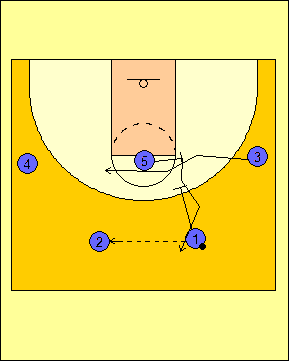
Diagram
1 |
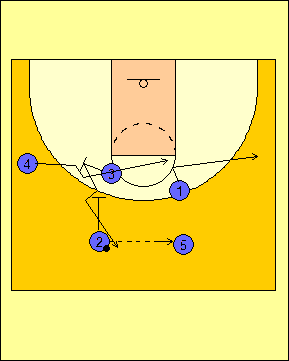
Diagram 2 |
If at any moment the cut over the top is taken away, we will look to get the
back cut off of the screen. In Diagram 3, this occurs and we look to take
advantage for the lay-up.
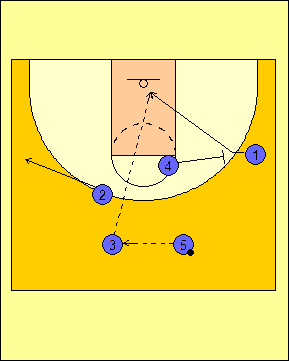
Diagram
3 |
Four Corners
The Four Corners offense was made famous by Dean
Smith's teams at North Carolina. The offense starts from a 1-4
high set with the wings breaking to the corners near the half court
line while the posts fill the corners (Diagram 4).
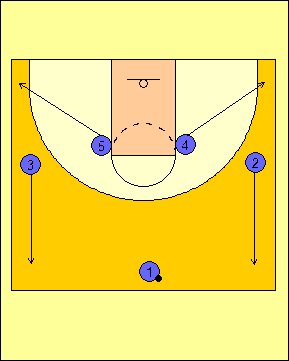
Diagram
4 |
The ball is passed to a corner once the offense is
initiated. In Diagram 5, the point guard passes to the corner
and #2 receives the basketball. #1 will look to step to the
middle and get the ball back. If unable to pass the ball
to #1, #2 will dribble towards the middle of the floor and #1 fills
his spot.
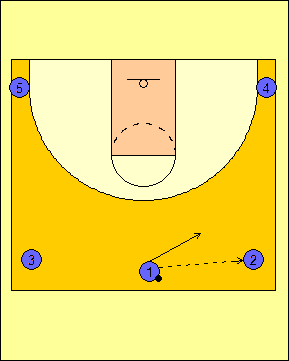
Diagram
5 |
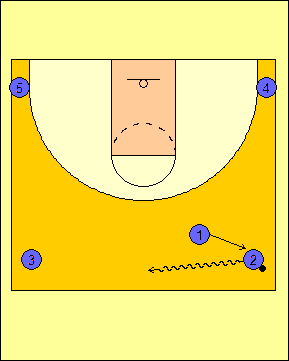
Diagram
6 |
It is imperative that the dribble be kept alive
until the decision is made to pass the basketball. The play in
Diagram 7 shows #2 dribbling at #1 who comes to the middle of the
floor. Once the pass is made, #2 fills the corner that #1
occupied as #1 takes the ball in the middle of the floor.
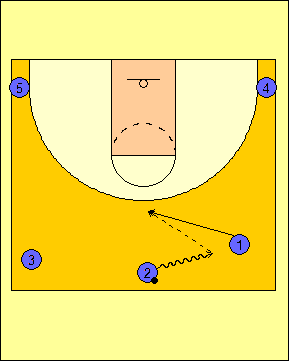
Diagram
7 |
If the opportunity presents itself, the perimeter
player with the basketball has the opportunity to drive the middle
(after beating his man) and set up a scoring opportunity for himself
or either one of the big men. The guard in Diagram 8 attacks
the basket as both bigs go up their respective sidelines before
breaking for the basket.
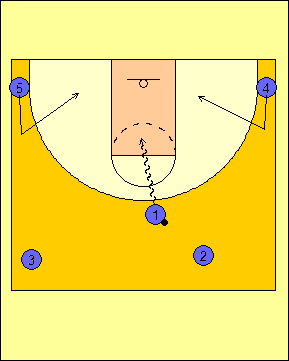
Diagram
8 |
False Motion Offense
Another type of delay offense is the False Motion Offense that was made popular
by Pete Newell. This offense relies on reading the defense as to whether
to cut backdoor or pop out to receive a perimeter pass. The offense starts
from a five-out look with players at the wings and in the corners as illustrated
in Diagram 9. When the pass is made by the point guard to initiate the
offense, he will make the first cut on a give-and-go. If he does not
get the ball, on the give-and-go, he will cut to the opposite corner while the
player starting in the corner of the side that received the pass will come up
and fill the wing.

Diagram
9 |
If a player makes a pass to reverse the basketball
and he does not get the ball back, the action in Diagrams 10 and 11
take place. The player at the wing will work along the free
throw line-extended and read the defender. If the defense sags
off, he will pop to the perimeter and receive the ball reversal.
If the defense does anything else, he will cut backdoor. The
backdoor is shown in Diagram 10 while the pop out is shown in
Diagram 11. If the pass is not made on the backdoor in this
sequence, the first cutter in the sequence will fill the corner.

Diagram
10 |

Diagram
11 |
If the ball is reversed, the player making the pass
will cut backdoor on the give-and-go (Diagram 12). If the pass
is not made, he will continue to the ball-side corner while the
player who starts the sequence in the corner on the side the reverse
pass was received will come to the wing.
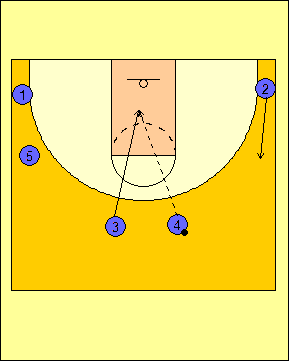
Diagram
12 |
If the ball is not passed on the give-an-go, the
scoring option can be set up with a backdoor cut. In Diagram
13, the passer does not receive the backdoor cut and fills the
corner opposite his side. The second cutter comes on a
backdoor and receives the pass for the lay-up in Diagram 14.
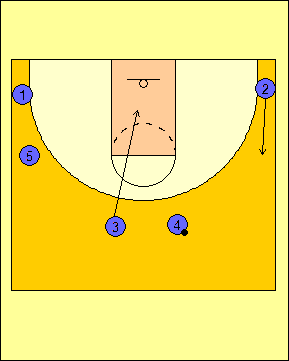
Diagram
13 |

Diagram
14 |
Hoya Offense
During Georgetown's run in the 1980's, John
Thompson's teams utilized the Hoya Offense. The offense starts
with two stacks high and the point guard taking the ball off of the
top (Diagram 15). When this happens, the player in the top of
the stack sets a down screen for the other player in the tandem.
The cutter will take a zipper cut to the top of the free throw
circle.
When the ball goes back to the top, the player who took the ball off
of the top fills the vacant spot and the screener stays where he was
initially (Diagrams 16 and 17).

Diagram
15 |
|

Diagram
16 |

Diagram
17 |
There are two scoring options in the offense other
than that of scoring in the offense. The first is to turn the
corner if the defense allows for dribble penetration on the dribble
to the wing (Diagram 18). The other, shown in Diagram 19,
occurs when the defense switches the screen. The screener
slips to the basket if there is a switch and looks for the ball on
the slip for the lay-up.
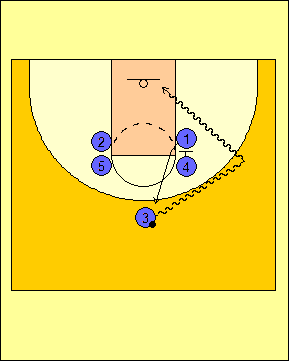
Diagram
18 |

Diagram
19 |
Teaching Delay Offenses
When teaching a Delay Offense, it is best to teach it
entirely utilizing a whole-method approach with five players on the
floor. With a more structured delay game like the High Flex, False
Motion, or Hoya Offenses, it is best to teach them from a five-on-zero
approach before putting a defense against the delay offense. With
a more loosely-structured system like the Four Corners Offense, coaches
can go straight to five-on-five and give pointers while teaching the
offense. If you use a code word like "Biola" to initiate the delay
game, explain it to your players before running the offense
five-on-five.
RETURN TO MEMBERSHIP AREA
© 2010-2017 Alan Peel Enterprises
|
 |